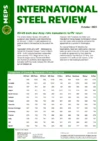Further price drops likely in US reinforcing bar market
The downward trend in reinforcing bar prices in the United States shows few signs of ending as domestic supply continues to outweigh consumption.
Steel manufacturers had been rolling material for stock as demand remained weak. Subsequently, supplies are now plentiful, with most common sizes and specifications – of both rebar in coil and straight bar – available from mill inventories within a matter of days.
This abundant supply has prompted US rebar producers to make further price reductions during July’s negotiations. A seasonally slow trading environment during the holiday period undermined this sales push, however.
MEPS International market analyst Chris Jackson said: “A demand/supply imbalance has been the catalyst for the recent price drop, and further deterioration is likely if the oversupply situation, domestically, is not significantly addressed.”
- This article draws on research conducted for the July edition of MEPS’s International Steel Review. The monthly publication features commentaries, prices, indices and forecasts covering key steel markets in North America, Asia and Europe. Contact MEPS for details of how to subscribe.
Service centres’ procurement activity remains subdued amid weak demand from end-users. Relatively high interest rates – imposed by the Federal Reserve to combat inflation – continue to weigh heavily on consumer and investor confidence. Consequently, rebar consumption the US’s residential construction sector is sluggish as many new house builds are being delayed.
Demand for rebar is likely to remain subdued, in August, and possibly into early September.
The US’s rebar suppliers will remain keen to plug shortfalls in their production schedules. Delivery lead times are not expected to extend because of mills’ summer maintenance outages. The lack of demand will largely offset their potential reduction of supply.
Reduced import pressure
The influence of import volumes on the US’s plentiful rebar supply is currently reduced. June’s steel import permit applications, for material from offshore origins, dropped by 10.7% month-on-month.
With the exception of material entering the US from Canada and Mexico – destined for midwestern and southern parts of the country – imports remain scarce. Many traditional sources of rebar imports are not currently competitive in terms of their prices or delivery lead times. Countries subject to the US’s 25% Section 232 import tariff are largely absent from the market.
Nations exempt from the Section 232 regulations, such as Brazil, have retained a presence in the US market, albeit a small one. The price gap between local and non-North American material has narrowed, however. This is due to the recent softening in domestic prices.
The same trend applies to European Union-origin material. Import price quotations are now being offered from Bulgaria and Greece, for end-of-year shipments. These offers also hold little appeal in price terms, however.
Uncertain economic outlook
MEPS respondents expect economics and politics will continue to have a major influence on market sentiment. November’s US presidential election adds a layer of uncertainty.
Recent economic data suggests that the Federal Reserve will implement interest rate cuts in the coming months, most likely during September. Nonetheless, any short-to-medium term positive influence from what is expected to be an incremental reduction in the cost of borrowing, is likely to be minimal.
US rebar mills do have some cause for optimism, though. This is primarily from a reduction in input costs during recent months.
Prices in the domestic scrap market have been supported by tighter supply and a rise in export volumes.

Source:
International Steel Review
The MEPS International Steel Review is an essential monthly publication, offering professional analysis and insight into carbon steel prices around the world.
Go to productRequest a free publication





